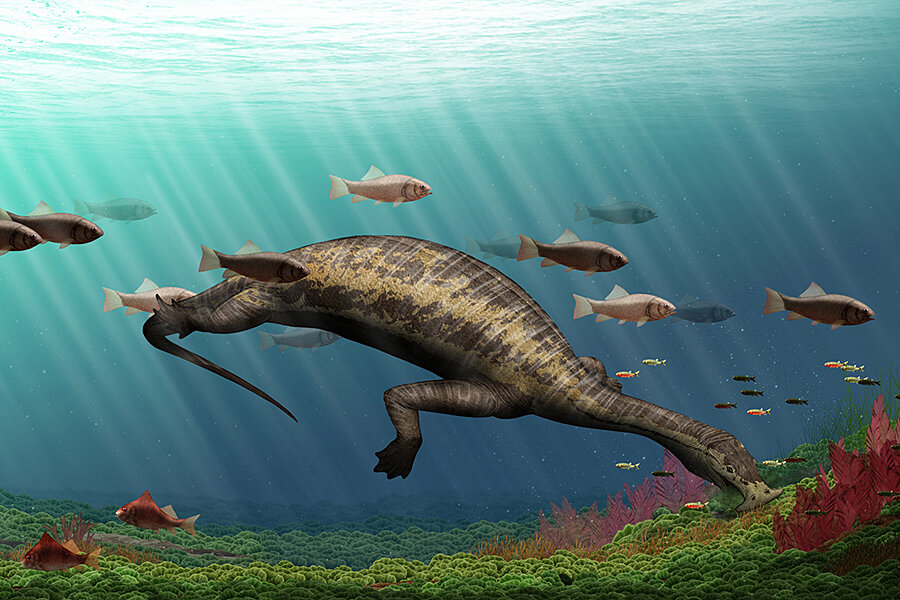Was this hammerhead herbivore the ocean's first vegetarian reptile?
Loading...
Scientists are gradually opening a window into the mysterious world of the rare herbivorous marine reptiles.
Most recently, in a study published Friday in the journal Science Advances, paleontologists have documented the earliest known marine reptile whose diet was herbivorous, the aptly named Atopodentatus unicus, Latin for "unique strangely toothed."
Not only is this hammerhead creature fascinating in its own right, said coauthor Olivier Rieppel, an evolutionary biologist at the Field Museum in Chicago, but it provides a glimpse into a world struggling to adapt after the devastation of the Permian mass extinction, offering evidence that life recovered more quickly than is often suggested.
"It's a very strange animal," said Dr. Rieppel in a press release. "It's got a hammerhead, which is unique. It's the first time we've seen a reptile like this."
This latest work centered on two new fossil specimens of A. unicus, discovered in Yunnan Province, China, which shattered previous hypotheses predicated upon a skull with a downturned snout.
Instead, it has a horizontal “hammerhead” shape, with the anterior edges of both upper and lower jaws “lined with batteries of chisel-shaped teeth,” say the researchers in their article. The remainder of the jaw is littered with “densely packed needle-shaped teeth forming a mesh.”
Researchers suggest the chisel-shaped teeth could have scraped algae from rocks on the seafloor, and then the maze of needle-like teeth could have filtered out the water, much like a baleen whale will sift plankton from seawater.
This marks a distinct departure from previous hypotheses, the authors write, which suggested that the supposed downturned snout "stir[red] up invertebrates in soft sediment in a flamingo-like manner."
If A. unicus did not actually eat invertebrates, as the researchers argue, then it is only the second ancient marine reptile ever identified to have developed herbivory – the other being Henodus, a Triassic turtle-like creature – and the earliest to have done so.
"The jaw structure is clearly that of an herbivore," said Dr. Rieppel. "It has similarities to other marine animals that ate plants with a filter-feeding system, but Atopodentatus is older than them by about eight million years."
And then there’s the shape, the hammerhead.
Most people will think of the eponymous shark, that iconic sea creature whose bizarre-looking head features banks of electroreceptors, as well as eyes perched at the very ends of the two protrusions.
Other vertebrates had similar adaptations, too – Diplocaulus from the Permian and Gerrothorax from the Triassic, for example – but the head function varies widely, with Diplocaulus likely using its more boomerang-shaped appendage for gaining lift. A. unicus is “unique in having a hammerhead adaptation for underwater grazing,” explained Rieppel.
The herbivorous reptile also offers insights into the resilience of life on Earth, as it bounced back from the carnage of mass extinction, said Rieppel.
"Animals living the years surrounding the Permian-Triassic extinction help us see how life on earth reacted" to the biggest extinction in Earth history, said Rieppel. "The existence of specialized animals like Atopodentatus unicus shows us that life recovered and diversified more quickly than previously thought," he said.
"And it's definitely a reptile that no one would have thought to exist," he added. "Look at it, it's crazy!"








